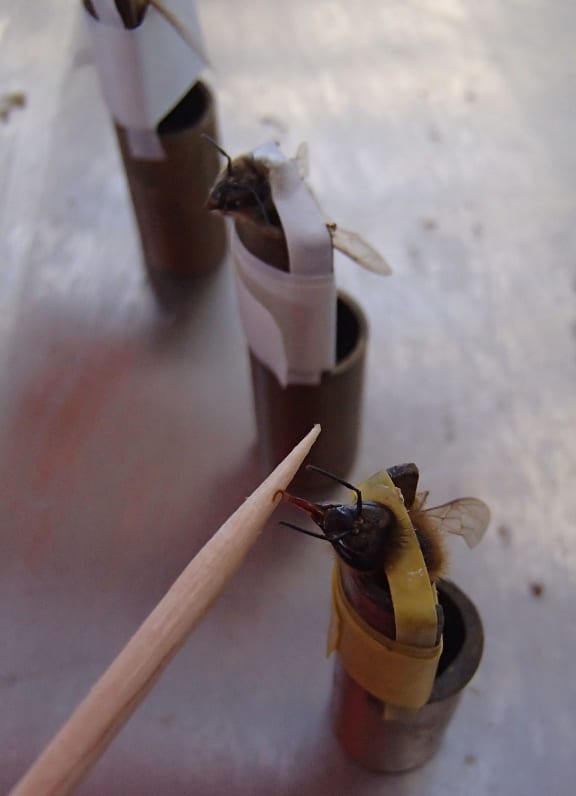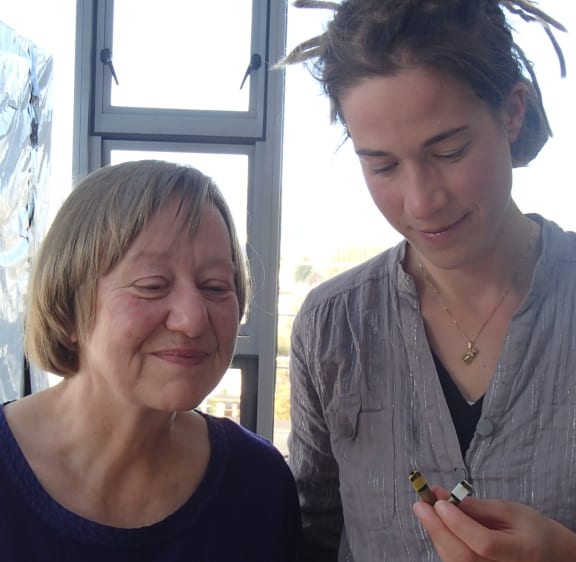
Tethered bees licking sugar water as part of an experiment to test their learning and memory. Photo: RNZ / Alison Ballance
Around the world, honeybees are facing a barrage of problems, from colony collapse disorder to varroa mite and pesticide exposure. And it now seems that even tiny amounts of pesticide may be enough to affect the health of a beehive.
Bees suffer from learning and memory problems after being exposed to very small doses of the pesticide chlorpyrifos, according to recent research from a team of zoologists and chemists at the University of Otago
Pesticides are widely used to protect crops, and although lethal doses have been calculated less work has been done on more subtle sub-lethal effects.
The University of Otago research involved chemist Kimberly Hageman’s previous research on the pesticide chlorpyrifos, with field work by zoologist Sue Michelsen-Heath to establish the levels of chlorpyrifos in bee hives across Central Otago. Post-doctoral research Elodie Urlacher then tested memory and learning in bees exposed to known doses of the pesticide in the lab.
What is chlorpyrifos?
Chlorpyrifos is an organo-phosphate insecticide. It is widely used in New Zealand, and in Central Otago it is used to control a hemipteran that is a pest on lucerne crops.
“It is relatively volatile,” says Kimberly, “which means a proportion of it is going to volatilise and move off-site. Then it may deposit back in the environment at sites that are a long way from where it was sprayed.”
But Kimberly is quick to point out that just because a chemical can be measured in the environment, this doesn’t mean it is causing any problems. She says her previous work wasn’t able to establish what a meaningful dose is for a bee, which is what this research involved.
Pesticide levels in bees in the field

Sue Michelsen-Heath and Elodie Urlacher looking at bees tethered in small metal tubes as part of an experiment. Photo: RNZ / Alison Ballance
PhD student Sue Michelsen-Heath collected bees from 27 different apiaries in Central Otago.
Sue says that low levels of pesticides were detected in bees in 17 per cent of the hives.
“The levels that we found were considerably lower than those that have been found in the United States, but we were still quite surprised to find that these levels were present,” says Sue.
Kimberly says the dose of pesticide they measured per bee in the field was at the level of picograms. By comparison, the LD50 dose – the dose which kills 50 per cent of bees – is much greater, at 100 nanograms.
Testing memory and learning in bees
In the lab experiments, Elodie used the dose of chlorpyrifos that had been measured in the field as the basis for testing bees.
Elodie used ‘associative learning’, which is what bees do in the field to make their foraging efficient. They learn to associate a signal, which might the colour, shape or smell of a flower, with the nectar or pollen reward they get from that flower.
In the lab, Elodie trained the bees – which are very fast learners – to stick their tongue out for a sugar reward when a particular odour was puffed over them. Once they had learned the association they would stick their tongue out whenever they smelt the correct odour.
Then she exposed the bees to tiny doses of chlorpyrifos and retested their abilities.
“In our studies only the highest dose had a large effect on learning. Lower doses still had an effect, but not as bad,” says Elodie.
Elodie says the pesticide had a more significant effect on memory, which she says has bigger implications for bees in the field, as they have to remember where to find good food sources.
“The main finding of the study is that a tiny dose of chlorpyrifos could completely interfere with the specificity of the memory,” says Elodie. “The bees that had been exposed to the pesticide tended to respond to all odours and not just the specific one they had been trained on.”
“This is the first time that anyone has linked a field study like this to a lab study,” says Kimberly.
Sue will be continuing the study, and will be testing bees in the field for memory and learning.
The paper "Measurements of Chlorpyrifos Levels in Forager Bees and Comparison with Levels that Disrupt Honey Bee Odor-Mediated Learning Under Laboratory Conditions" was published in the Journal of Chemical Ecology (2016).

